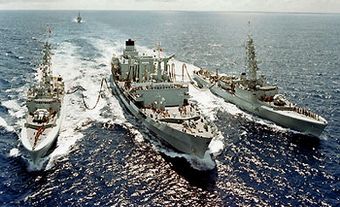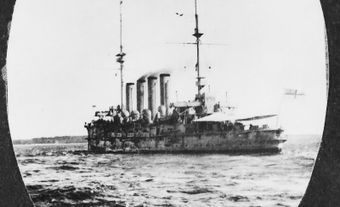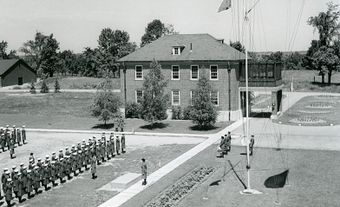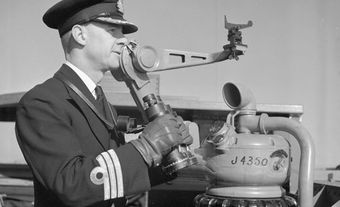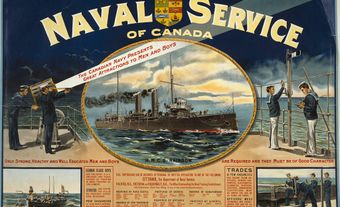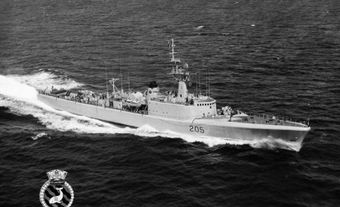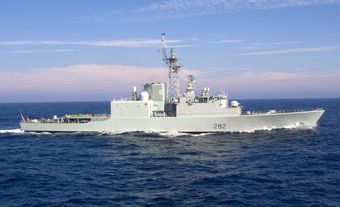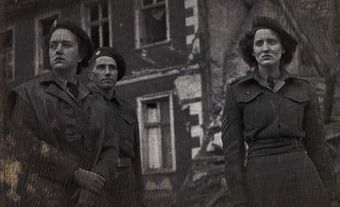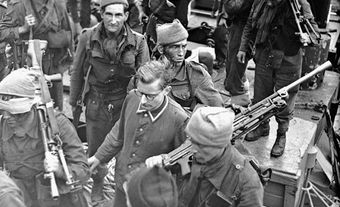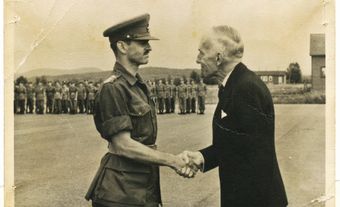The HMCS Haida is a “Tribal” Class destroyer that served in the Second World War and the Korean War. It is a National Historic Site operated by Parks Canada and is moored in Hamilton Harbour. The Haida is known as Canada’s “fightingest” warship.
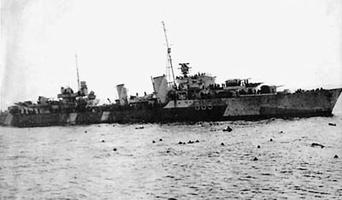
Tribal Class Destroyer
The HMCS Haida, a powerful Second World War "Tribal" Class destroyer, was commissioned on 30 August 1943 and built in England for the Royal Canadian Navy. It was one of eight “Tribal” Class destroyers delivered to the Canadian navy. In total, 27 were built for the navies of Canada, Australia and Great Britain.

Ship's Company, H.M.C.S. HAIDA, Plymouth, England, 22 May 1944
(Photo by Lt Richard Graham Arless, Canada. Dept. of National Defence, courtesy Library and Archives Canada / PA-176124)
Second World War
The HMCS Haida’s first duty was escorting supply convoys to the Soviet port of Murmansk, above the Arctic Circle. During this service, the Haida and its crew helped sink the German battlecruiser Scharnhorst, earning their first battle honour. The ship was then transferred to Plymouth, along with sister ships the HMCS Athabaskan and HMCS Huron.
During operations in the English Channel, the HMCS Athabaskan was hit by a German torpedo and sank on the night of 29–30 April 1944. The Haida forced one German destroyer aground and damaged another. It then returned to the site where Athabaskan had been hit and picked up 42 members of its crew. However, as dawn approached it had to leave the area, due to concerns about German dive bombers. Another 85 men were rescued by the Germans and became prisoners of war. In total, 128 crew members of the Athabaskan died.

HMCS HAIDA’s motor cutter, which was used to rescue survivors of the sinking of HMCS ATHABASKAN on 29 April 1944. (L-R): Stoker William Cummins, Leading Seaman William MacLure, Able Seaman Jack Hannam.
(photo by Lt William Sclater, Canada. Dept. of National Defence, courtesy Library and Archives Canada / PA-152033)
The Haida patrolled the English Channel and the Bay of Biscay from January 1944 to January 1945. It also participated in the Normandy Invasion on 6 June 1944. The Haida returned to Halifax for a refit in September 1944. In the last year of the war, it again escorted convoys to Murmansk and took part in the liberation of Norway.
The HMCS Haida became famous for its role in the destruction of several German ships. Between April and September 1944 alone, it sank nine enemy ships. In total, the Haida helped sink 14 ships during the Second World War.

Commander H.G. DeWolf, Commanding Officer, on the bridge of HMCS HAIDA, England, 18 September 1943.
(photo by Lt Herbert J. Nott, Canada. Dept. of National Defence, courtesy Library and Archives Canada / PA-141695)
Did you know?
Harry DeWolf, who commanded HMCS Haida in 1943 and 1944, was one of Canada’s most decorated naval heroes. He served more than 40 years in the Canadian navy and was eventually promoted to vice-admiral. DeWolf suffered from seasickness throughout his naval career and said he could only sleep while sitting up.
Korean War
After peacetime service from 1947 to 1950, the HMCS Haida was refitted with modern armament and reclassified as a destroyer-escort. From 1952 to 1954, it served with United Nations forces in Korea (see Korean War). During its two tours of duty, the Haida protected aircraft carriers and blockaded supply lines. It also helped blow up communist supply trains as they sped along the coast in what was known as “train busting.”

USS BUCK transferring four-inch ammunition to HMCS HAIDA during her patrol off the east coast of Korea, 9 June 1953.
(photo by Allan F. Jones, Canada. Dept. of National Defence, courtesy Library and Archives Canada / PA-138197)
HMCS Haida National Historic Site
The Haida remained in service with the Royal Canadian Navy until 11 October 1963. The next year friends and admirers bought it, and in 1970 it was taken over by the Ontario government and moved to Ontario Place, Toronto, as a memorial. In 1984, the Historic Sites and Monuments Board of Canada designated HMCS Haida as a national historic site. More than 30 years later, the HMCS Haida was transferred to Parks Canada. In 2002, it was towed to dry docks on the Welland Canal in St. Catharines for repairs. The following year, it moved to Hamilton and in June 2004, it opened as a National Historic Site. It is moored at Pier 9 in Hamilton Harbour. The Haida is the only surviving “Tribal” Class destroyer.

 Share on Facebook
Share on Facebook Share on X
Share on X Share by Email
Share by Email Share on Google Classroom
Share on Google Classroom



